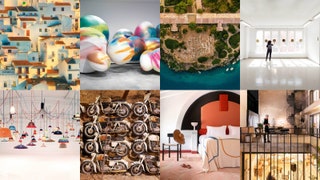MENORCA
THE BALEARIC REVIVAL
Is Menorca emerging as an axis of the contemporary art world? It might seem unlikely, given its conservative reputation, but Swiss art magnates Iwan and Manuela Wirth have a habit of disrupting expectations. Best known for turning a Somerset farm into a multi-purpose destination, the couple have chosen a windswept islet in Mahón harbor for their latest addition.
The gallery opens in July with a show by LA-born painter Mark Bradford – whose US pavilion for the 2017 Venice Biennale was a powerful rumination on slavery and the American Civil War – housed in the sustainably repurposed outbuildings of a former naval hospital, alongside a restaurant run by pioneering local winery Binifadet.
‘Isla del Rey is completely immersed in nature and has been a place of contemplation for millennia,’ says Manuela, referring to the ruins of a sixth-century basilica which can be visited along with a sculpture trail featuring works by Louise Bourgeois and Eduardo Chillida set in gardens designed by Piet Oudolf.
Menorca’s art scene currently comprises a few commercial galleries and municipal art spaces. Whether H&W Menorca will galvanize this modest ecosystem remains to be seen, though it will surely boost the island’s growing conservation-focused profile and fresh locations continue to emerge, providing attractive retreats for art enthusiasts.
CÁCERES
THE RURAL UPSTART
Two significant developments have put the small Extremadura city of Cáceres on the map. One was the success of Atrio, a two-Michelin-starred restaurant located in a mansion reimagined by architects Luis Moreno Mansilla and Emilio Tuñón.
The second was the Museum of Contemporary Art Helga de Alvear. German-born, Spanish-based collector De Alvear established the museum to house her collection of 20th- and 21st-century art after discovering Cáceres, unveiling the first phase in 2010.
The new wing, opened this spring, has astonished locals with its elegant modernism and the unerring quality of its contents. Entrance is free, and residents have taken to posing for selfies among large-scale pieces by Olafur Eliasson and Katharina Grosse. Ai Weiwei’s Descending Light, made of 60,000 glass beads, has become a highlight.
With Cáceres emerging from its provincial slumber, an art route is developing, with stops at the Museo de Cáceres for its modern Spanish masters and a space devoted to Fluxus artist Wolf Vostell, whose post-industrial work punctuates the landscape.
The surroundings of De Alvear’s museum are still ripe for improvement, yet Julián Gómez’s Kernel gallery on Plaza Marrón demonstrates the potential impact of a new wave of art-savvy visitors.
CARABANCHEL
THE CITY ENCLAVE
This vibrant barrio in southwest Madrid was never a household name, known mainly for its factories and hard-rock gigs. However, a recent influx of creatives has revitalized the area.
Driven out of the center by rising costs and attracted by the proximity of Matadero, a cultural hub in an old slaughterhouse beside the River Manzanares, artists have commandeered Carabanchel’s rich supply of garages, printworks, and textile workshops.
The main nexus is around Oporto metro station, where collectives such as Mala Fama and Nave Oporto have established their presence. Another hotspot is found in the Comillas quarter, where designer Alvaro Catalán de Ocón operates a remarkable converted factory that hosts under-the-radar concerts.
Although natural-wine bars, artisan bakers, and boutique hotels remain scarce, residents appreciate the authentic character of the area. Painter and singer Alberto Acinas, a longtime resident, hopes that Carabanchel avoids becoming another version of New York’s SoHo, as he and his colleagues initially fled from gentrification.




